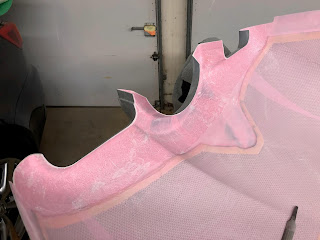Hours: 5
I worked on the cowl hinges today. First I trial bent the upper hinge parts to match the fuselage curvature. The hinge pins also get a slight bend and the ends of the pins are slightly tapered to aid insertion. Some builders use quik-lock screws for the cowling attachment, but I prefer the clean looks of the hinge method. Once you get the proper bend in the pins, insertion and removal is pretty easy and I think quicker than quit-lock screws.
Here are the hinges attached to the fuselage.
I was pleased that the upper cowl fit very nicely between the fuselage and the back of the spinner with no additional trimming.
The instructions advise that you fit the upper cowling to allow for the engine sagging as the rubber mounts break in. Here I've attached some aluminum angle with the specified offset. The aluminum angle will rest on the spinner and insure the proper offset.























